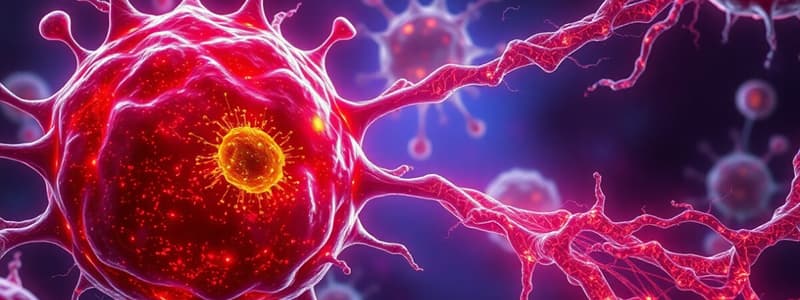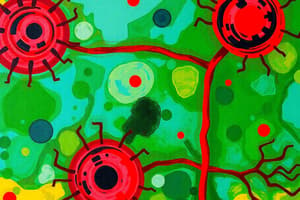Podcast
Questions and Answers
What characterizes necrosis in cells?
What characterizes necrosis in cells?
- Cell swelling and organellar breakdown (correct)
- Normal cellular function preservation
- Programmed cell death
- Inducing immunity responses
Which of the following factors is NOT a cause of cell injury?
Which of the following factors is NOT a cause of cell injury?
- Microbiologic agents
- Genetic defects
- Controlled exercise (correct)
- Nutritional imbalances
Apoptosis is best described as:
Apoptosis is best described as:
- A programmed mechanism of cell death (correct)
- A type of necrosis
- Cell injury due to hypoxia
- Uncontrolled cell proliferation
Which intracellular system is vulnerable due to cell injury?
Which intracellular system is vulnerable due to cell injury?
Which condition distinguishes hypoxia from ischaemia?
Which condition distinguishes hypoxia from ischaemia?
Which form of cell injury is characterized by severe trauma or extreme temperatures?
Which form of cell injury is characterized by severe trauma or extreme temperatures?
What primary effect does hypoxia have on cellular processes?
What primary effect does hypoxia have on cellular processes?
Which type of dietary imbalance has been implicated in the pathogenesis of atherosclerosis?
Which type of dietary imbalance has been implicated in the pathogenesis of atherosclerosis?
What enzyme is primarily responsible for causing ATP depletion during ischemic injury?
What enzyme is primarily responsible for causing ATP depletion during ischemic injury?
What is a common outcome of reversible hypoxic injury?
What is a common outcome of reversible hypoxic injury?
Which of the following is NOT associated with irreversible injury?
Which of the following is NOT associated with irreversible injury?
What occurs during the accumulation of intracellular sodium due to hypoxia?
What occurs during the accumulation of intracellular sodium due to hypoxia?
What is a significant effect of toxic oxygen radicals during reperfusion of ischemic tissue?
What is a significant effect of toxic oxygen radicals during reperfusion of ischemic tissue?
What process indicates the loss of structural features in the cell during hypoxia?
What process indicates the loss of structural features in the cell during hypoxia?
Which compound is a common mediator of cell death in the context of ischemic injury?
Which compound is a common mediator of cell death in the context of ischemic injury?
What is a consequence of ischemic injury related to membrane integrity?
What is a consequence of ischemic injury related to membrane integrity?
What is cytoplasmic eosinophilia primarily due to?
What is cytoplasmic eosinophilia primarily due to?
What characterizes fatty change in cells?
What characterizes fatty change in cells?
Which morphological change is common in necrotic cells?
Which morphological change is common in necrotic cells?
Karyolysis is characterized by which of the following?
Karyolysis is characterized by which of the following?
What type of necrosis is characterized by the preservation of structural outlines for days?
What type of necrosis is characterized by the preservation of structural outlines for days?
Which type of necrosis results from bacterial or fungal infections and often leads to tissue liquefaction?
Which type of necrosis results from bacterial or fungal infections and often leads to tissue liquefaction?
Gangrenous necrosis involves which of the following?
Gangrenous necrosis involves which of the following?
What is unique about caseous necrosis?
What is unique about caseous necrosis?
What is most often the site of fatty change in the body?
What is most often the site of fatty change in the body?
Which of the following conditions may lead to fatty change?
Which of the following conditions may lead to fatty change?
What characterizes xanthomas in the body?
What characterizes xanthomas in the body?
What is the microscopic appearance of glycogen accumulation?
What is the microscopic appearance of glycogen accumulation?
In the condition of pathologic calcification, what is primarily accumulating?
In the condition of pathologic calcification, what is primarily accumulating?
What is a likely effect of severe fatty change in liver cells?
What is a likely effect of severe fatty change in liver cells?
Which pigment is derived from hemoglobin and indicates excess iron in tissues?
Which pigment is derived from hemoglobin and indicates excess iron in tissues?
What happens to the morphology of liver cells in mild fatty change?
What happens to the morphology of liver cells in mild fatty change?
What is one of the ways free radicals might be generated within a cell?
What is one of the ways free radicals might be generated within a cell?
Which of the following components is primarily affected by oxygen free radicals?
Which of the following components is primarily affected by oxygen free radicals?
What role do copper and iron play in free radical formation?
What role do copper and iron play in free radical formation?
Which of the following describes a mechanism of chemical injury related to toxins?
Which of the following describes a mechanism of chemical injury related to toxins?
What is an indicator of reversible cell injury visible under a light microscope?
What is an indicator of reversible cell injury visible under a light microscope?
How does mercury cause chemical injury to cells?
How does mercury cause chemical injury to cells?
Which of the following is NOT a type of injury caused by free radicals?
Which of the following is NOT a type of injury caused by free radicals?
What compound is carbon tetrachloride metabolized into that is toxic to cells?
What compound is carbon tetrachloride metabolized into that is toxic to cells?
Flashcards are hidden until you start studying
Study Notes
Cell injury
- Cells try to maintain a stable internal environment.
- When cells are exposed to stress or harmful stimuli, they can adapt to maintain viability.
- Cell injury occurs when the adaptive capability is exceeded.
- Two main patterns of cell death: necrosis and apoptosis.
- Necrosis is caused by exposure to harmful conditions and is characterized by cell swelling, protein denaturation, and organelle breakdown.
- Apoptosis is a programmed cell death that occurs in normal or physiological conditions.
Causes of cell injury
- Hypoxia: Insufficient oxygen supply, impedes aerobic respiration.
- Physical agents: Trauma, temperature extremes, radiation, electric shock, sudden pressure changes.
- Chemicals and drugs: Can alter membrane permeability, osmotic balance, or disrupt enzyme function.
- Microbiologic agents: From viruses to parasites.
- Immunologic reactions: Immune system can cause cell damage, like anaphylaxis.
- Genetic defects: Conditions like Down’s syndrome and sickle cell anemia.
- Nutritional imbalances: Protein-calorie deficiency, vitamin deficiencies.
- Aging: Leads to cellular dysfunction over time.
Mechanisms of cell injury
- Cell response depends on the type, duration, and severity of the injury.
- The consequences also depend on the cell type, health status, and adaptability.
- Four intracellular systems are vulnerable to injury:
- Cell membrane integrity: Maintaining ionic and osmotic balance.
- Aerobic respiration: Production of energy.
- Protein synthesis: Building and repairing cellular components.
- Genetic apparatus: DNA and RNA integrity.
- Calcium plays a significant role:
- High levels of intracellular calcium activate enzymes that damage the cell
- Phospholipases: degrade membranes
- Proteases: break down structural proteins
- ATPases: deplete ATP
- Endonucleases: fragment DNA
- High levels of intracellular calcium activate enzymes that damage the cell
- Oxygen free radicals are important mediators of cell death.
Ischemic and hypoxic injury
- Reversible injury:
- Decreased ATP production leads to impaired sodium pump, causing sodium influx
- Sodium influx leads to water accumulation and cell swelling.
- Reduced pH due to anaerobic glycolysis and lactic acid accumulation.
- Detachment of ribosomes from the endoplasmic reticulum impairs protein synthesis.
- Irreversible injury:
- Severe mitochondrial damage and calcium accumulation.
- Extensive plasma membrane damage.
- Swelling of lysosomes.
- Continued loss of cellular components and leak of lysosomal enzymes into the cytoplasm.
- Formation of myelin figures, whorled masses of phospholipids.
Mechanisms of irreversible injury
- Progressive loss of membrane phospholipids.
- Cytoskeletal abnormalities: Detachment of the cell membrane.
- Toxic oxygen radicals: Released after reperfusion, damage cells.
- Lipid breakdown products: Have detergent effects on cell membranes.
Free radical mediation of cell injury
- Free radicals are highly reactive molecules with unpaired electrons.
- They can be generated by:
- Absorption of radiant energy: e.g., hydrolysis of water to hydroxyl radicals.
- Redox reactions: normal metabolic processes, e.g., superoxide radicals, hydrogen peroxide, hydroxyl radicals.
- Enzymatic catabolism of oxygenous chemicals: e.g., carbon tetrachloride metabolism in the liver produces free radicals.
- Free radicals react with:
- Lipid peroxidation of plasma membranes.
- DNA: damage to thymine bases.
- Cross-linking of proteins.
Chemical injury
- Two main mechanisms:
- Direct combination with a critical molecular component or cellular organelle: e.g., mercury binds to sulfhydryl groups, disrupting ATP-dependent transport.
- Conversion to reactive toxic metabolites: e.g., carbon tetrachloride (CCl4) converted to free radicals in the liver, causing damage to the endoplasmic reticulum and fatty liver changes.
Patterns of acute cell injury
- Reversible cell injury:
- Light microscopy:
- Cell swelling: small clear vacuoles in the cytoplasm.
- Cytoplasmic eosinophilia due to loss of ribosomes.
- Fatty change: seen in hypoxic and chemical injury.
- Electron microscopy:
- Plasma membrane: blebbing, distortions, loosened attachments.
- Mitochondrial changes: swelling, phospholipid accumulation.
- Endoplasmic reticulum: dilatation, ribosome detachment.
- Nuclear alterations: disaggregation of granular elements.
- Light microscopy:
- Necrosis:
- Morphological changes following cell death in living tissue.
- Characterized by enzymatic digestion and protein denaturation.
- Hydrolytic enzymes from the dead cell (autolysis) or from leukocytes (heterolysis).
- Cytoplasmic changes: eosinophilia, glassy appearance, vacuolation, calcification.
- Nuclear changes:
- Karyolysis: DNA digestion.
- Pyknosis: nuclear shrinkage and increased basophilia.
- Karyorrhexis: fragmentation of the pyknotic nucleus.
Types of necrosis
- Coagulative necrosis:
- Preservation of the structural outlines of the dead cell or tissue.
- Occurs in myocardial infarction.
- Liquefactive necrosis:
- Characterized by tissue dissolution and liquefaction.
- Occurs in bacterial and fungal infections and in the CNS.
- Gangrenous necrosis:
- Ischemic coagulative necrosis with superimposed infection and liquefaction.
- Caseous necrosis:
- Characteristic of tuberculosis, with cheesy appearance.
Accumulation of cellular substances
- Fatty change (steatosis):
- Accumulation of triglycerides in cells, primarily in the liver.
- Can be caused by toxins, diabetes, protein malnutrition, obesity, and anoxia.
- Cholesterol and cholesterol esters:
- Accumulation in macrophages, forming foamy cells.
- Found in atherosclerosis and xanthomas (fat accumulation in connective tissues).
- Proteins:
- Accumulate in the kidneys in glomerular diseases with proteinuria.
- Glycogen:
- Accumulate in disorders of glucose or glycogen metabolism.
- Pigments:
- Melanin: brown pigment in skin cells, involved in freckles.
- Hemosiderin: golden-brown pigment, accumulates in tissues with excess iron.
Pathologic Calcification
- Abnormal accumulation of calcium salts (and other minerals) in tissues.
Studying That Suits You
Use AI to generate personalized quizzes and flashcards to suit your learning preferences.




